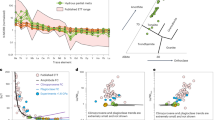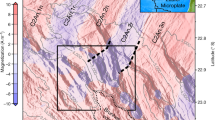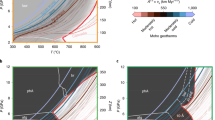Abstract
ARCHEAN geothermal gradients have often been supposed to be much steeper than those of today1 –6. Because heat generation from the decay of radioactive nuclides in the Earth was then much greater4,7,8, extra heat, if it escaped by conduction, must have been carried along steeper thermal gradients. Significant measurements of terrestrial conductive thermal gradients are very difficult to obtain, and estimates of thermal gradients in the past are even harder to make. Estimates made from igneous and metamorphic rock occurrences are of limited value both because igneous rocks occur at levels in the earth shallower by unknown amounts than those at which they form and because nearly all igneous and metamorphic rocks are formed at plate boundaries where thermal gradients are much steeper than within plates. In plate margin areas, advective and convective processes dominate so that the normal conductive gradient of the lithosphere can only be measured or estimated in areas away from plate boundaries. We show here that the rocks of the Superior Province (formed roughly in the interval 3,100–2,500 Myr ago) were not subjected to steep regional geothermal gradients after their assembly into a continent by lateral accretion of island arcs8, and hence that the extra Archean heat escaped the Earth in some way other than by conduction through the continent. We suggest that this escape was mainly by cooling of the ocean floor as a boundary conduction layer.
This is a preview of subscription content, access via your institution
Access options
Subscribe to this journal
Receive 51 print issues and online access
$199.00 per year
only $3.90 per issue
Buy this article
- Purchase on Springer Link
- Instant access to full article PDF
Prices may be subject to local taxes which are calculated during checkout
Similar content being viewed by others
References
Fyfe, W. S. Phil. Trans. R. Soc., Lond. A 273, 315 (1973).
Baer, A. J. PreCambrian Res. 5, 249 (1977).
Strong, D. F. & Stevens, R. K. Nature 249, 545 (1974).
Lambert, R. St. J. in The Early History of the Earth 363 (ed. Windley, B. F. Wiley, London, 1976).
Windley, B. F. in The Evolving Continents 62 (Wiley, London, 1977).
Lubimova, E. A. Monog. Am. geophys. Un. 13, 63 (1969).
Lee, W. H. K. thesis, Univ. California.
Burke, K., Dewey, J. F. & Kidd, W. S. F. in The Early History of the Earth 113 (ed. Windley, B. F. Wiley, London, 1976).
Goodwin, A. M. Geol. Assoc. Can. Spec. Paper 11 527 (1972)
Wise, D. U. in The Geology of Continental Margins 83 (eds Burk, C. A. & Drake, C. L. (Springer, New York, 1974).
Hall, D. H. Geol. Ass. Can. Spec. Paper 9 137 (1971).
Harris, P. G., Kennedy, W. Q. & Scarfe, C. M. Geol. J. Spec. Issue 2, 187 (1970).
Dewey, J. F. & Burke, K. J. Geol. 81, 683–692 (1973).
Clark, S. P. & Ringwood, A. E., Rev. Geophys. 2, 35 (1964).
Brooks, C. & Hart, S. R. Geology 2, 107 (1974).
McKenzie, D. P. & Weiss, N. O. Geophys. J. R. astr. Soc. 42, 131 (1975).
Author information
Authors and Affiliations
Rights and permissions
About this article
Cite this article
BURKE, K., KIDD, W. Were Archean continental geothermal gradients much steeper than those of today?. Nature 272, 240–241 (1978). https://doi.org/10.1038/272240a0
Received:
Accepted:
Issue Date:
DOI: https://doi.org/10.1038/272240a0
This article is cited by
-
Growth of continental crust in intra-oceanic and continental-margin arc systems: Analogs for Archean systems
Science China Earth Sciences (2022)
-
A resolution of the Archaean paradox
Nature (2013)
-
Vanished diamondiferous cratonic root beneath the Southern Superior province: evidence from diamond inclusions in the Wawa metaconglomerate
Contributions to Mineralogy and Petrology (2012)
-
Application of the modern ophiolite concept with special reference to Precambrian ophiolites
Science China Earth Sciences (2011)
-
Elastic strength of the Slave craton at 1.9 Gyr and implications for the thermal evolution of the continents
Nature (1990)
Comments
By submitting a comment you agree to abide by our Terms and Community Guidelines. If you find something abusive or that does not comply with our terms or guidelines please flag it as inappropriate.



